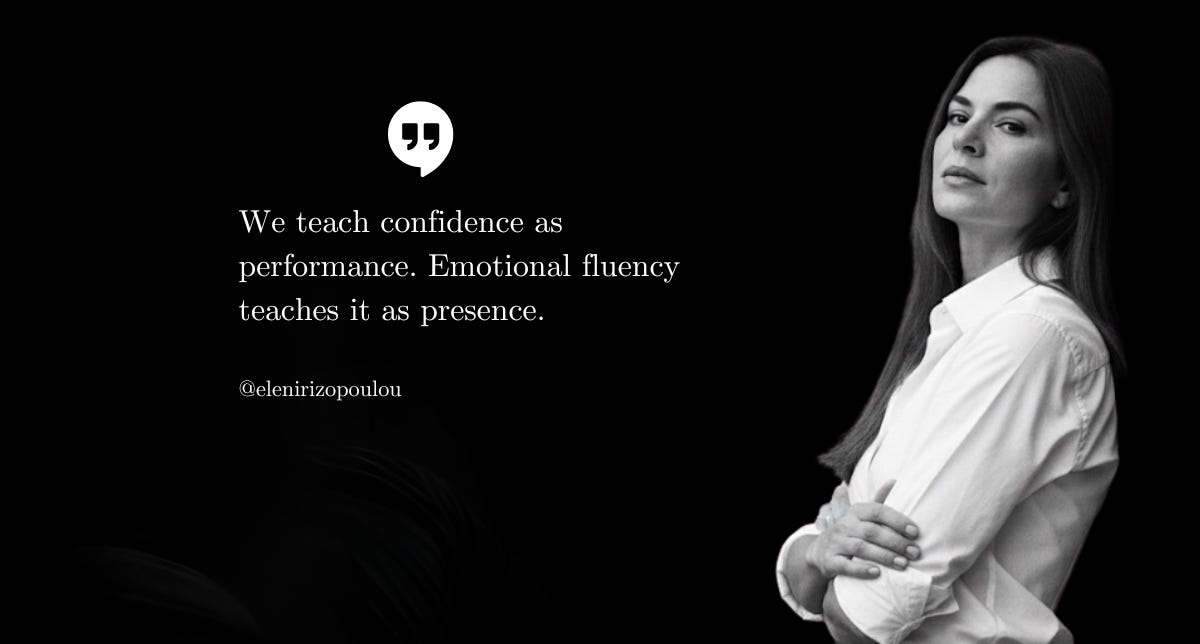High-sensitivity is not a weakness, it’s an edge. If you know how to use it.
Emotional fluency and the two frameworks that gave me my voice back
Chapter 33
You know what you want to say.
You’ve rehearsed it a hundred times in your head. You’ve crafted the perfect version, the one where you sound confident, clear, unbothered. The one where people finally get it.
And then the moment comes.
Your chest tightens. Your voice shrinks. Your nervous system takes the mic and says, “Let’s not make this uncomfortable.” The words that felt so sharp in your mind turn to mush in your mouth. You say something adjacent to what you meant. Something safer. Something that won’t make waves.
And afterward, you replay it on loop. “Why didn’t I just say what I meant?”
If this sounds familiar, you’re not broken. You’re not weak. And you’re definitely not alone.
You’re simply running a brilliant mind on an unregulated nervous system, trying to lead without emotional fluency.
What emotional fluency actually means
Ever met someone who swears they’re “great with emotions”?
Until the room fills with one. Until someone cries, flinches, or withdraws, and they feel that pull in their own chest to look away, fix, or make it stop.
It’s not that they don’t care. It’s because they were never taught how to stay.
Most of us weren’t either. We don’t lack empathy. We lack capacity, the ability to stay present when the moment gets uncomfortable.
That’s emotional fluency. The language we were never taught to speak.
It’s the ability to name what’s happening inside you, translate it into language that lands, and deliver it without apologizing for your existence.
Most leadership training teaches you what to say. Emotional fluency teaches you how to access what you need to say, and then actually say it.
It’s the difference between:
“I think maybe we should consider possibly revisiting this timeline?” (half-voice)
“This timeline doesn’t work. Here’s why, and here’s what I need instead.” (fluency)
For quiet leaders, introverts, high-sensitive founders, empaths, people who process deeply before they speak, the gap between knowing and saying can feel like a canyon.
And it’s not exclusively a leadership skill. It’s a human one.
It’s what allows you to sit with your friend’s heartbreak without rushing to solve it.
To tell your partner, “I’m hurt,” instead of going silent.
To name your own fear in the middle of change and stay curious instead of defensive.
Emotional fluency means identifying what’s happening in your body, giving it words your mind can understand, and expressing it in a way others can receive.
What you’re missing is the internal operating system that makes those skills accessible.
Why high-sensitivity is your edge
Let’s get something straight, your nervous system isn’t sabotaging you. It’s doing exactly what it was designed to do, scan for safety, read the room, protect you from threat.
The problem? Most leadership environments, and, frankly, the world we live in, weren’t built for nervous systems like ours.
They reward whoever speaks first, loudest, and longest. They mistake confidence for clarity. They confuse performance with presence.
And if you’re highly sensitive, an empath, introverted, or slow-to-speak? You’ve probably been told, directly or indirectly, that you need to be someone else to lead well.
That’s bullshit.
High-sensitivity is not a weakness. It’s pattern recognition. It’s emotional depth. It’s the ability to read what’s actually happening in a room, not just what people are saying.
But your edge only works if you know how to use it. How to unmute it.
Because all that insight, all that clarity, all that depth? It doesn’t matter if it stays locked inside your head.
The two frameworks that changed everything
If you need to know one thing about me, it’s this: I’m not here to fix you. I’m here to hold your hand while you remember how to hold your own. I’m here to share my voice and feel everything, loudly, messily, and on purpose. To name the things we’ve all been taught to hide. To remind you that softness is still strength.
I’m not here to play expert. I’m here to tell the truth. And if that truth helps you find your own, we’ve both done our job.
That happens through my two frameworks. One for accessing your voice. One for shaping what you say.
If you’ve ever felt like your voice disappears when the pressure’s on, what comes next was built for you. Two frameworks designed to unmute your truth and help you lead without losing yourself.
1. UNMUTE™ Framework: Your process for finding your voice
Most people don’t struggle with communication skills. They struggle with access.
Access to what they actually think. Access to what they need. Access to their own voice when it matters most.
You know that moment when you’re in a conversation and your brain goes blank? When the thing you wanted to say dissolves the second you try to speak it? When you walk away and five minutes later, the perfect response appears, fully formed, too late?
That’s not a confidence problem. It’s not an intelligence problem. It’s a nervous system problem.
Your body is doing what it was designed to do: protect you. But somewhere along the way, “speaking up” got coded as “dangerous.” Maybe you were shut down as a kid. Maybe you were punished for being “too much” or “too sensitive.” Maybe you learned that silence was safer than honesty.
UNMUTE rewires that. It gives you a process to move from internal truth to external fluency, without overriding your nervous system, just working with it.
Here’s how it works:
U – Uncover: Notice the truth you’re avoiding
The sentence that starts with “I probably shouldn’t say this, but…” That’s the one. When you feel resistance, friction, or discomfort in a conversation, pause. Ask yourself: What am I not saying right now?
N – Name: Call it what it is (without apology)
No softening. No apology. Just the plain, unvarnished truth. “I’m frustrated.” “This isn’t working.” “I need something different.” Write it in one sentence. No hedging. You don’t have to say it out loud yet. But you have to be able to name it clearly to yourself first.
M – Map: See how silence or half-voice is costing clarity
Not speaking up doesn’t keep the peace. It erodes trust, with others, and with yourself. Map the cost: If I don’t say this, what does it cost me? The team? What pattern am I reinforcing? When you map the cost, speaking up stops feeling optional.
U – Unstick: Reframe the language holding you back
Catch the scripts running in the background. “I don’t want to be difficult” becomes “I’m being clear, not difficult.” “Maybe it’s just me” becomes “If I’m feeling this, others probably are too.” Replace language that keeps you small with language that assumes you belong in the conversation.
T – Translate: Turn your insight into a script that lands
This is where internal truth becomes external influence. Clear. Direct. Human. Not “You always interrupt me”, try “I’ve tried to share this idea twice, and both times the conversation moved on. Can we go back to it?”
E – Embed: Practice until fluency is your default
Practice the scripts out loud. Start small with low-stakes situations. Notice when you default to old patterns and course-correct in real time. Track your wins. Fluency comes from repetition, until it stops feeling like a script and becomes how you naturally speak.
2. BE YOURSELF™ Framework: Turning insight into influence
Once you’ve accessed your voice, the next step is learning how to shape it so it lands. Because your words deserve to have impact. Your truth deserves to be communicated. And your voice deserves to be heard, clearly, without losing yourself in the process.
BE YOURSELF was built for connection, not performance.
For anyone who’s tired of diluting their message just to sound acceptable.
For the leaders, creators, and quiet people who want to express what’s real, without pretending to be louder, tougher, or different than they are.
It’s a framework that helps you turn what you really think, the raw version, into language that carries both clarity and weight.
Because when your words match your inner voice, that’s when people really listen.
B – Begin with honesty
Open with something raw. A flaw. A doubt. An observation most people are too scared to admit. The first sentence determines whether someone leans in or checks out.
E – Expose the tension
Show the conflict. The thing that doesn’t add up. The gap between what we say and what we actually do. Tension is magnetic, it’s the cognitive dissonance we all feel but rarely name.
Y – Yield to vulnerability
Let them see the human side. Not the performative one. The version that doesn’t have it figured out yet. This is where authority earns trust.
O – Offer your shift
Share the insight. The realization. The thing that changed for you. This is where you move from relatable to useful.
U – Unlock the takeaway
Give them a principle they can carry forward. Make it portable. Make it sticky. This is the sentence they’ll screenshot.
R – Relate it to them
Connect your story to their experience. Make it universal, not just personal. This is where “I” becomes “we.”
S – Simplify the action
One practical step. Not ten. One. Make it doable. Make it human. Something they can do today.
E – Encourage reflection
Invite them to pause. To rethink. To sit with the discomfort of a new question. Real change happens in the pause.
L – Leave a feeling
Close with a line that lingers. Emotional. Memorable. The thing they’ll repeat to someone else later.
F – Finish with resonance
End not just with words, but with weight and intention. Make it echo. Let it stay with them long after the moment has passed.
How they work together?
UNMUTE gets you to clarity.
BE YOURSELF gives you the structure to deliver it.
Use UNMUTE when you’re stuck, when your voice feels locked, when you’re trying to name the emotion sitting in your body, when you know something needs to be said but can’t quite access it yet.
Use BE YOURSELF when you need to communicate your truth with impact, whether you’re in a meeting, writing an email, leading a presentation, having a hard conversation, or showing up online.
Together? They’re your operating system for leading without losing yourself.
Note: I’ll be diving even deeper into both frameworks, with real scripts, specific scenarios, and step-by-step walkthroughs, in an upcoming Playbook I’m finishing soon. Consider this your preview.
What this actually looks like in practice
Let’s look at how these frameworks actually work in real moments, where your voice tends to get stuck.
Scenario 1. Let’s say you’re in a meeting. Someone steamrolls your idea. You feel the heat rising in your chest. Your jaw tightens. You want to say something, but the moment passes, and now it’s too late.
Later, you replay it for hours. You craft the perfect comeback in the shower. You tell yourself you’ll speak up next time. (You won’t.)
With emotional fluency, you:
Uncover: “I’m angry because my idea was dismissed without discussion.”
Name: “That felt dismissive.”
Map: “If I don’t address this, it’ll happen again. And I’ll keep shrinking.”
Unstick: “I’m not being difficult by naming this. I’m being clear.”
Translate: “Hey, can we go back to what I said earlier? I don’t think it landed, and I’d like to unpack it.”
Embed: Practice saying versions of this until it feels normal. Not aggressive. Not apologetic. Normal.
That’s the difference. Not louder. Not bolder. Fluent.
Scenario 2. Now let’s say it’s not a meeting but a conversation with someone you love.
They say something that stings, and you freeze. Your body registers it before your mind does, your chest tightens, your voice retreats, the air thickens with everything you don’t say.
It lingers. For hours, maybe days. You replay it, rewrite it, resent it, or worse, turn it inward and blame yourself for staying silent. You re-live the moment with a hundred words trapped inside you.
Without emotional fluency, you swallow it and call it peace.
With it, you stay present enough to name it.
Uncover: “That comment hurt more than I expected.”
Name: “I feel unseen.”
Map: “If I stay silent, this distance grows.”
Unstick: “Naming this doesn’t create conflict, it restores honesty.”
Translate: “When you said that, it felt dismissive. Can we talk about it?”
Embed: Practice this honesty until it stops feeling like confrontation and starts feeling like care.
That’s emotional fluency too.
And the examples go on and on, from boardrooms to living rooms. I’ll be unpacking more of them soon in my upcoming playbook.
Why this matters right now
We grew up learning to manage emotions, not understand them. To hide what felt too heavy, too loud, too inconvenient, because belonging often required self-abandonment.
We learned to smile through discomfort, to stay agreeable in rooms that misread silence as weakness, to make ourselves smaller in the name of harmony.
And now, in the age of AI, that conditioning is colliding with a new reality. Machines can already outthink us, outpace us, out-analyze us. But they can’t feel for us. They can’t sense tension in a room, hold space for uncertainty, or speak truth with compassion.
That’s on us. That’s what staying human means now, learning to regulate, to reconnect, to translate what we feel into what we say without losing ourselves.
You didn’t step into your work, your mission, or your relationships to shrink. You did it because you saw something broken and believed you could make it better. But if you can’t name what you see, articulate what you need, or hold your ground when it gets uncomfortable, your vision stays locked inside you.
I’ve been there: the one with too many thoughts and not enough words. It’s not that I didn’t know what to say, I just couldn’t find a way to say it without losing myself in the process.
That’s what emotional fluency gave me back: access to my own voice. And it’s not a skill you master once, it’s a practice you return to every day. The tools I’m building, the scripts, the playbook, and more, they’re not theory. They’re the process that helped me stop shrinking and start speaking again.
They’re what I wish I’d had twenty years ago, when I was surrounded by louder voices. Or when I was dealing with heartbreak, disappointment, and the exhausting habit of people-pleasing my way through every season of life.
When I was overthinking, over-giving, over-explaining, trying to be heard without ever truly saying anything out of fear of rejection.
You don’t need to become someone else to lead well. You need to become fluent in being yourself.
Where we go from here
Here’s what I know about you.
You’re the one who notices what others overlook. You read between the pauses, sense the shift in the room before anyone speaks. You know what needs to be said, maybe you’ve known for a while.
But when the moment arrives, something inside you freezes. And the words stay unspoken.
Your nervous system throws up a wall between what you know and what you can actually say. And you walk away wondering why you can’t just be like the people who talk without thinking, who fill every silence, who never seem to second-guess themselves.
I used to think that too.
I used to think my sensitivity was the problem. That I needed to be louder, sharper, less me. I spent years trying to sound like the leaders I admired, until I realized they weren’t teaching me how to lead. They were teaching me how to perform.
And performance is really exhausting when it’s not actually you.
The shift came when I stopped trying to sound confident and started getting fluent. When I began listening to what my body was actually feeling, naming my emotions instead of repeating “I’m fine” to myself and everyone else. That’s when I realized I didn’t need a different voice. I needed access to my own.
A way to work with my nervous system, not against it. A language that let me tell the truth without abandoning myself.
That’s what these two frameworks gave me. And that’s what I’m giving you.
This isn’t the end of the conversation. It’s the beginning.
From here, I’ll keep uncovering what really happens in those unseen moments, the pause before we speak, the silence that holds our truth, the tension between fear and expression.
Because this work isn’t about communication tips or quick wins. It’s about rewiring how we relate to ourselves and to each other. About turning self-awareness into self-expression. And remembering that fluency, in emotion, in voice, in truth, is the real measure of leadership.
It’s a language you learn, a muscle you build, a practice you return to every time you feel the gap between what you know and what you can say.
If you’re tired of rehearsing perfect responses that never make it out of your mouth…
If you’re done shrinking to make others comfortable…
If you’re ready to lead as yourself, not as the loudest person in the room…
Let’s unmute.
The world doesn’t need more people who talk without thinking, or move through life without feeling.
It needs more of you, the ones who think deeply, feel fully, and finally speak with the weight your truth deserves.
Stay messy. Stay brave. Stay fluent in what you feel.
Eleni
You can’t lead anyone if you’ve abandoned your own voice.—Eleni Rizopoulou
👉 Let’s build emotional fluency together. Let’s open this dialogue.
Where do you notice your voice go quiet, at work, at home, or inside your own head?
💬 Did you find the frameworks relatable?
Tell me what part of emotional fluency you’d like me to explore next.
Every Monday at 10:30 CEST, The Glorious Fail shows up to meet you where you are, and push you where you’re meant to go.
The Glorious Fail is just getting started. And every voice here shapes what it becomes. We’re unlearning the silence, reclaiming the story, and writing a braver one, together. There are plenty of ways to support it:
→ If this landed a little too close to home, give it a like.
→ If you have thoughts, feedback, or just want to say hi, drop a comment.
→ And if it cracked something open and want to spread the word, hit that restack button below.
💭 Want more emotional fluent related brain-bending insights? [Follow me on Linkedin]








Eleni, thank you for writing about this. I can really relate, not necessarily because of learning the skill itself, but because I might hold a different perspective on the same issue. My whole life, I’ve been good at expressing and explaining my inner world, but I was often told I was “too much.”
We also live in a world that is only now beginning to recognize that sensitivity and emotional intelligence aren’t weaknesses, but real-life skills. As you know (I share about this in my work as well), I’ve had to learn accountability for myself after being muted and cancelled.
Thank you for the reminder to keep doing the work and continue polishing the skill.🫶
To be honest, this time, you have lost me at half of the reading. I have to stop there as,
- reason 1: I can only get so much into my head at one time.
- reason 2: This got me thinking it's not a good idea to learn and apply directly — especially the thing about vulnerability in our daily lives as employees, for example. (And, most leaders are employees themselves, so someone is their manager, or customer-facing entrepreneurs who also should keep strong, not unfold every itch they scratch that day to the other people. Saying »I don't know but I'll have a look, please bear with me for a moment«)
- this thing about "being myself" generally: I had to postpone it until I understood myself more. When I felt like a fool, I better did not act as one, the way is to "debug" and find out why.
I like the first part though.
»When you feel resistance, friction, or discomfort in a conversation, pause. Ask yourself: What am I not saying right now?« on to knowing how to communicate assertively. This can not only be done in meetings, but also alone when facing tasks or reading books. We can pause and listen to ourselves, that levels the emotional flood so that we can see better what's ahead.
That's just my way — since I learned to listen to myself, I don't go oversharing any longer about my hustles. Instead I label them inside of myself, and then gently move on. If the hustles need to be talked about therein, then rather criticise things, not people.